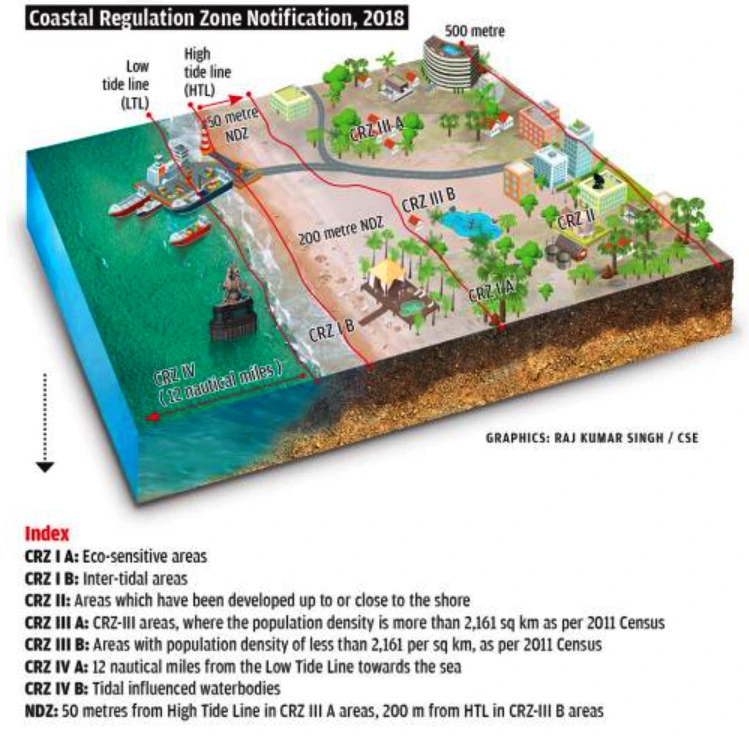Context:
The National Green Tribunal (NGT) has asked the Ministry of Environment, Forest and Climate Change to ensure that coastal States and Union Territories prepare the Coastal Zone Management Plan (CZMP).
Prepare Coastal Zone Management Plans without delay, NGT tells Coastal States and UTs
- The National Coastal Zonal Management Authority (NCZMA) issued a direction in August 2023 that all coastal States/Union Territories, whose CZMPs/ICRZP were yet to be finalized as per 2019 notification, must complete it within October 31, 2023.
- It has been reported that only three States – Odisha, Karnataka and Maharashtra – have formulated the Coastal Zone Management Plan (CZMP) as per the Coastal Regulation Zone notification, 2019.
- Only Great Nicobar and Little Andaman Islands have approved the Island CRZP as per the notification.
What is Coastal Zone Management Plan?
- Coastal Zone Management Plan: It involves managing coastal areas to balance environmental, economic, human health, and human activities.
- The Coastal Zone Management Plan: It encourages coastal states and UTs to work in partnership with the Union government to design and enforce local programs and Projects consistent with the Coastal Regulation Zone and accompanying regulations.
What is a Coastal Regulation Zone (CRZ)?
- The Ministry of Environment and Forests (MoEF) under the Environment Protection Act, 1986, issued the Coastal Regulation Zone notification for regulation of activities in the coastal area.
- Definition: As per the notification, the coastal land up to a distance of 500m from the High Tide Line (HTL) and a stage of 100m along banks of creeks, estuaries, backwaters and rivers subject to tidal fluctuations, is called the Coastal Regulation Zone (CRZ).
High Tide Lines (HTL):
- HTL is defined as the line on the land up to which the highest water line reaches during the Spring Tides.
Low Tide Lines (LTL):
- LTL is defined as the line on the land up to which the lowest water line reaches during the Spring Tides.
Spring Tide:
- Spring tide occurs on the full moon and new moon day. High tides of spring tide are higher than the average high tide and low tide of spring tide is lower than the average low tide.
|
- CRZ along the country has been placed in four categories, which are as follows:
-
CRZ I – Ecologically Sensitive Areas.
- Location: They lie between the low and high tide lines.
- In this area, exploration of natural gas and salt extraction are permitted
-
-
CRZ II – Shore Line Areas
- Location: The areas that have been developed up to or close to the shoreline.
- Unauthorized structures are not allowed to be constructed in this zone.
-
CRZ III – Undisturbed Area
- Location: Rural and Urban localities that fall outside I and II.
- Only certain activities related to agriculture even some public facilities are allowed in this zone.
-
CRZ IV – Territorial Area
- Location: An area covered between the Low Tide Line and 12 Nautical Miles seaward.
- Fishing and allied activities are permitted in this zone.
- No solid waste should be discharged in this zone.
-
New Reforms under Coastal Regulation Zone Notification 2018 & 2019 Are as follows:
-
- Development projects: A No Development Zone (NDZ) of 20 meters has been stipulated for all Islands.
- New CRZ Categories: For CRZ-III (Rural) areas, two separate categories have now been created for improved management: CRZ-III A and CRZ-III B
- CRZ-III A: Rural Areas that are densely populated with a population density of 2161/km2. They will have an NDZ of 50 meters from HTL. Earlier it was 200m from HTL according to the CRZ Notification of 2011.
- CRZ-III B: Rural Areas that are densely populated with a population density of 2161/km2. They will have an NDZ of 200m from HTL.

About National Green Tribunal (NGT)
- It was established in 2010 under the National Green Tribunal Act 2010 for effective and expeditious disposal of cases relating to environmental protection and conservation.
- It is a specialized body equipped with the necessary expertise to handle environmental disputes involving multi-disciplinary issues.
- The Tribunal is not bound by the procedure laid down under the Code of Civil Procedure, 1908, but guided by principles of natural justice.
|
Source: The Hindu
![]() 16 Jan 2024
16 Jan 2024

